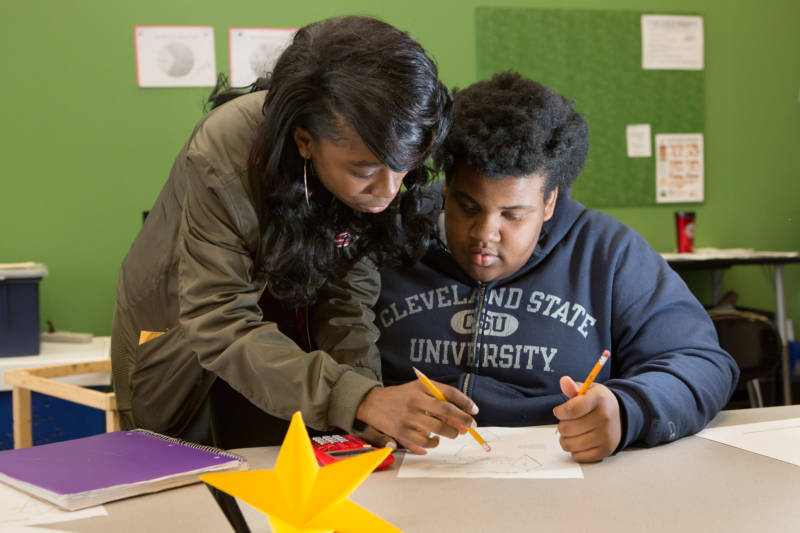Teaching metacognitive skills
According to Cover, the Lakeview School District has had “a big equity push” in recent years, with two organizations being brought in to lead monthly dialogues for cohorts of about 15 faculty members. Those dialogues prompted Cover to reflect on areas where she had struggled in school — primarily writing.
“I recalled that I learned to write by doing rewrites on English and history papers,” she says. “So why not bring more complex math problems and do the same in my class?”
Cover says her most helpful writing teachers did not just tell her what was wrong, such as passive voice, and expect her to fix it. They gave examples that modeled active voice. She adopted the same approach for math. In addition to showing the steps to solving problems, she now models metacognitive skills in class by explaining how she thinks and what thinking strategies she uses for tackling problems. For example, when working on the whiteboard, she draws thought bubbles in which she jots notes about her problem-solving choices. These informal annotations help answer the question, “How do I know how to do this?”
After her examples, Cover’s students practice explaining their own problem-solving choices during class, enabling them to tackle more challenging exam questions than previous years’ students might have. Take, for example, this garden-variety trig problem: If cos(theta)=3/4, what is cos(-theta)? As Cover explains, a student may get this question right based on memorization, rather than understanding odd and even functions.
On her new tests, Cover is more likely to ask a question like this: Explain how cosine is even by using the unit circle. These types of questions not only stimulate deeper thinking; they give Cover “very clear feedback on what students don’t know.”
During the exams, some students mimic Cover’s thought bubbles to explain their thinking. Others write full sentences. After the first attempt, Cover returns tests with feedback that probes for more information or highlights spots where problem-solving went awry. Students have one class period to complete their first revision. For the second, they have a half period before submitting for an official grade.
McKenna Evans, a recent Lakeview graduate, says that the metacognitive challenge of Cover’s tests stressed her out at first. But the opportunity to revise her work ultimately built her confidence. “Being able to see what I got wrong helped me learn for future tests. Going into the last couple tests of the trimester I felt very prepared because I was taught after each test the mistakes I was making.”
The revision process has not resulted in perfect achievement, though. According to Cover, the final distribution of grades has been similar to previous years, but each mark represents a deeper level of comprehension than in the past. She sees evidence of that not only on the exams but in classroom conversations, which connects to another of NCTM’s eight essential teaching practices: facilitation of “meaningful mathematics discourse” among students.
“The students are talking more about the process. I’m hearing them ask (one another), ‘How did you know to do that?’” Cover says. “All of the sudden they realize their thinking matters.”
That’s where equity comes into play. Cover knows that most of her students won’t need to graph sine waves in the future. But assessing a problem, developing strategies for solving it, and communicating about those strategies are skills that transfer beyond math class. Cover wants to see all students encouraged to practice those skills — not just those who have been labeled as “good at math.”
Last year, Cover had a senior who was failing at one point in the trimester but revised some of her tests and ultimately earned a ‘C.’ In a private conversation, Cover told the student how much she admired her work ethic. Contrasted with negative messages the student had received elsewhere, Cover’s affirmation brought the student to tears.
“Why are we making our kids feel this way?” Cover asks, referring to what she sees as a pervasive trend of defining students by test scores.
By transforming her assessment practices, Cover has worked to define her students as learners — and to enable them to see themselves that way, too. The shift “makes me happy to go to work,” she says.
Making the change
Lakeview High School operates on trimesters, which gave Cover multiple opportunities to practice and refine her new exam model last year. This year, she tested the waters with her algebra classes: she integrated metacognitive skills into lessons, added one deeper question per test, and gave students the opportunity to revise that section. Starting small and scaling up is what Cover recommends to other teachers who want to bring more metacognitive skills into their classes. Though some teachers may question if extra time for revisions can fit into their course schedule, Cover says that with the changes in both trig and algebra, she has seen dividends in student retention of concepts during the trimester. “Is it better to cover one more unit or really send home the other four-to-six units to all students?” she asks.
For Cover, there were greater challenges than time. “I used to classify myself as a control freak,” she says. Changing her teaching and assessment practices after nearly 18 years at Lakeview meant trusting her students more and asking them to trust her as they navigated new territory.


